GO语言中defer实现原理是什么
来源:亿速云
时间:2023-03-08 08:59:00 201浏览 收藏
对于一个Golang开发者来说,牢固扎实的基础是十分重要的,golang学习网就来带大家一点点的掌握基础知识点。今天本篇文章带大家了解《GO语言中defer实现原理是什么》,主要介绍了defer、go语言,希望对大家的知识积累有所帮助,快点收藏起来吧,否则需要时就找不到了!
这篇文章主要介绍“GO语言中defer实现原理是什么”的相关知识,小编通过实际案例向大家展示操作过程,操作方法简单快捷,实用性强,希望这篇“GO语言中defer实现原理是什么”文章能帮助大家解决问题。
defer 是什么
咱们一起来看看 defer 是个啥
是 GO 中的一个关键字
这个关键字,我们一般用在释放资源,在 return 前会调用他
如果程序中有多个 defer ,defer 的调用顺序是按照类似栈的方式,后进先出 LIFO的 ,这里顺便写一下
栈
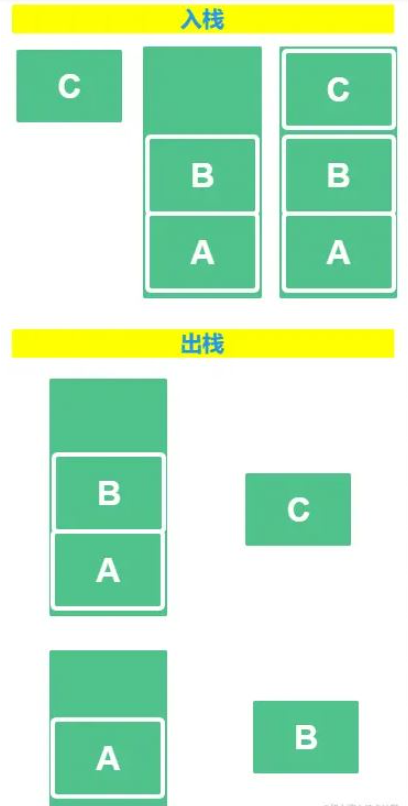
遵循后进先出原则
后进入栈的,先出栈
先进入栈的,后出栈
队列
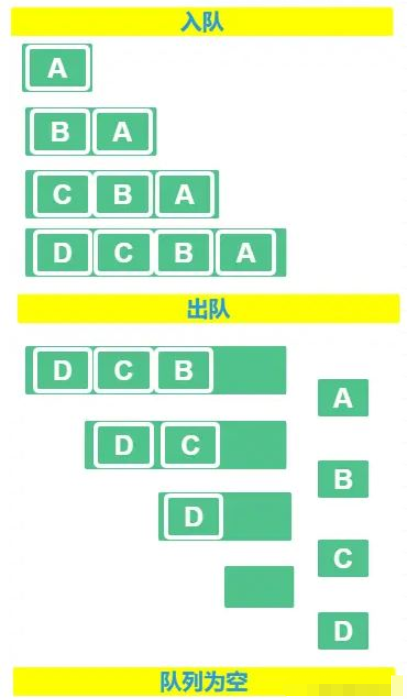
遵循先进先出 , 我们就可以想象一个单向的管道,从左边进,右边出
先进来,先出去
后进来,后出去,不准插队
defer 实现原理
咱们先抛出一个结论,先心里有点底:
代码中声明 defer的位置,编译的时候会插入一个函数叫做 deferproc ,在该defer所在的函数前插入一个返回的函数,不是return 哦,是deferreturn
具体的 defer 的实现原理是咋样的,我们还是一样的,来看看 defer的底层数据结构是啥样的 ,
在 src/runtime/runtime2.go 的 type _defer struct {结构
// A _defer holds an entry on the list of deferred calls.
// If you add a field here, add code to clear it in freedefer and deferProcStack
// This struct must match the code in cmd/compile/internal/gc/reflect.go:deferstruct
// and cmd/compile/internal/gc/ssa.go:(*state).call.
// Some defers will be allocated on the stack and some on the heap.
// All defers are logically part of the stack, so write barriers to
// initialize them are not required. All defers must be manually scanned,
// and for heap defers, marked.
type _defer struct {
siz int32 // includes both arguments and results
started bool
heap bool
// openDefer indicates that this _defer is for a frame with open-coded
// defers. We have only one defer record for the entire frame (which may
// currently have 0, 1, or more defers active).
openDefer bool
sp uintptr // sp at time of defer
pc uintptr // pc at time of defer
fn *funcval // can be nil for open-coded defers
_panic *_panic // panic that is running defer
link *_defer
// If openDefer is true, the fields below record values about the stack
// frame and associated function that has the open-coded defer(s). sp
// above will be the sp for the frame, and pc will be address of the
// deferreturn call in the function.
fd unsafe.Pointer // funcdata for the function associated with the frame
varp uintptr // value of varp for the stack frame
// framepc is the current pc associated with the stack frame. Together,
// with sp above (which is the sp associated with the stack frame),
// framepc/sp can be used as pc/sp pair to continue a stack trace via
// gentraceback().
framepc uintptr
}_defer 持有延迟调用列表中的一个条目 ,我们来看看上述数据结构的参数都是啥意思
| tag | 说明 |
|---|---|
| siz | defer函数的参数和结果的内存大小 |
| fn | 需要被延迟执行的函数 |
| _panic | defer 的 panic 结构体 |
| link | 同一个协程里面的defer 延迟函数,会通过该指针连接在一起 |
| heap | 是否分配在堆上面 |
| openDefer | 是否经过开放编码优化 |
| sp | 栈指针(一般会对应到汇编) |
| pc | 程序计数器 |
defer 关键字后面必须是跟函数,这一点咱们要记住哦
通过上述参数的描述,我们可以知道,defer的数据结构和函数类似,也是有如下三个参数:
栈指针 SP
程序计数器 PC
函数的地址
可是我们是不是也发现了,成员里面还有一个link,同一个协程里面的defer 延迟函数,会通过该指针连接在一起
这个link指针,是指向的一个defer单链表的头,每次咱们声明一个defer的时候,就会将该defer的数据插入到这个单链表头部的位置,
那么,执行defer的时候,我们是不是就能猜到defer 是咋取得了不?
前面有说到defer是后进先出的,这里当然也是遵循这个道理,取defer进行执行的时候,是从单链表的头开始去取的。
咱们来画个图形象一点
在协程A中声明2个defer,先声明 defer test1()
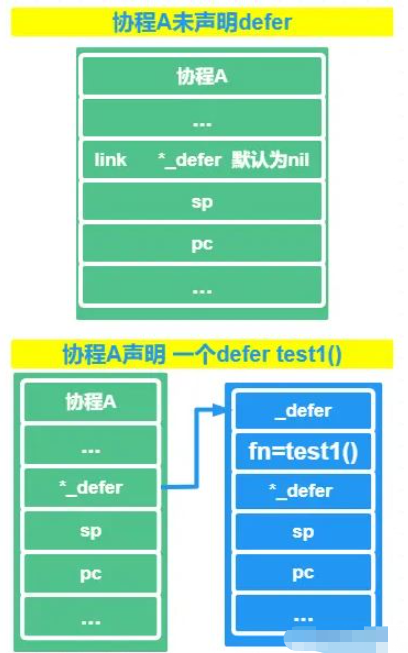
再声明 defer test2()
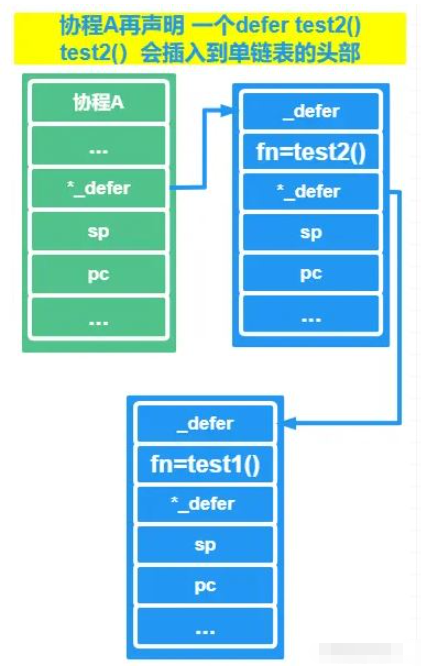
可以看出后声明的defer会插入到单链表的头,先声明的defer被排到后面去了
咱们取的时候也是一直取头下来执行,直到单链表为空。
咱一起来看看defer 的具体实现
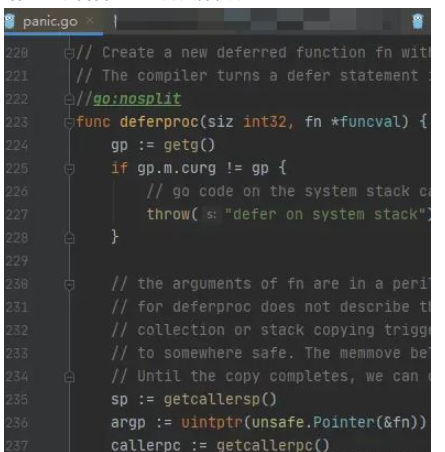
源码文件在 src/runtime/panic.go 中,查看 函数 deferproc
// Create a new deferred function fn with siz bytes of arguments.
// The compiler turns a defer statement into a call to this.
//go:nosplit
func deferproc(siz int32, fn *funcval) { // arguments of fn follow fn
gp := getg()
if gp.m.curg != gp {
// go code on the system stack can't defer
throw("defer on system stack")
}
// the arguments of fn are in a perilous state. The stack map
// for deferproc does not describe them. So we can't let garbage
// collection or stack copying trigger until we've copied them out
// to somewhere safe. The memmove below does that.
// Until the copy completes, we can only call nosplit routines.
sp := getcallersp()
argp := uintptr(unsafe.Pointer(&fn)) + unsafe.Sizeof(fn)
callerpc := getcallerpc()
d := newdefer(siz)
if d._panic != nil {
throw("deferproc: d.panic != nil after newdefer")
}
d.link = gp._defer
gp._defer = d
d.fn = fn
d.pc = callerpc
d.sp = sp
switch siz {
case 0:
// Do nothing.
case sys.PtrSize:
*(*uintptr)(deferArgs(d)) = *(*uintptr)(unsafe.Pointer(argp))
default:
memmove(deferArgs(d), unsafe.Pointer(argp), uintptr(siz))
}
// deferproc returns 0 normally.
// a deferred func that stops a panic
// makes the deferproc return 1.
// the code the compiler generates always
// checks the return value and jumps to the
// end of the function if deferproc returns != 0.
return0()
// No code can go here - the C return register has
// been set and must not be clobbered.
}deferproc 的作用是
创建一个新的递延函数 fn,参数为 siz 字节,编译器将一个延迟语句转换为对this的调用
getcallersp():
得到deferproc之前的rsp寄存器的值,实现的方式所有平台都是一样的
//go:noescape func getcallersp() uintptr // implemented as an intrinsic on all platforms
callerpc := getcallerpc():
此处得到 rsp之后,存储在 callerpc 中 , 此处是为了调用 deferproc 的下一条指令
d := newdefer(siz):
d := newdefer(siz) 新建一个defer 的结构,后续的代码是在给defer 这个结构的成员赋值
咱看看 deferproc 的大体流程
获取
deferproc之前的rsp寄存器的值使用
newdefer分配一个 _defer 结构体对象,并且将他放到当前的_defer链表的头初始化_defer 的相关成员参数
return0
来我们看看 newdefer的源码
源码文件在 src/runtime/panic.go 中,查看函数newdefer
// Allocate a Defer, usually using per-P pool.
// Each defer must be released with freedefer. The defer is not
// added to any defer chain yet.
//
// This must not grow the stack because there may be a frame without
// stack map information when this is called.
//
//go:nosplit
func newdefer(siz int32) *_defer {
var d *_defer
sc := deferclass(uintptr(siz))
gp := getg()
if sc 0 {
d = pp.deferpool[sc][n-1]
pp.deferpool[sc][n-1] = nil
pp.deferpool[sc] = pp.deferpool[sc][:n-1]
}
}
if d == nil {
// Allocate new defer+args.
systemstack(func() {
total := roundupsize(totaldefersize(uintptr(siz)))
d = (*_defer)(mallocgc(total, deferType, true))
})
}
d.siz = siz
d.heap = true
return d
}newderfer 的作用:
通常使用per-P池,分配一个Defer
每个defer可以自由的释放。当前defer 也不会加入任何一个 defer链条中
getg():
获取当前协程的结构体指针
// getg returns the pointer to the current g. // The compiler rewrites calls to this function into instructions // that fetch the g directly (from TLS or from the dedicated register). func getg() *g
pp := gp.m.p.ptr():
拿到当前工作线程里面的 P
然后拿到 从全局的对象池子中拿一部分对象给到P的池子里面
for len(pp.deferpool[sc]) <p><img src="/uploads/20230308/16782372046407de14e1250.png" alt="GO语言中defer实现原理是什么"></p><p>点进去看池子的数据结构,其实里面的成员也就是 咱们之前说到的 <code>_defer</code>指针</p><p>其中 <code>sched.deferpool[sc]</code> 是全局的池子,<code>pp.deferpool[sc]</code> 是本地的池子</p><p><strong>mallocgc</strong>分配空间</p><p>上述操作若 d 没有拿到值,那么就直接使用 <code>mallocgc</code> 重新分配,且设置好 对应的成员 <code>siz</code> 和 <code>heap</code></p><pre class="brush:go;">if d == nil {
// Allocate new defer+args.
systemstack(func() {
total := roundupsize(totaldefersize(uintptr(siz)))
d = (*_defer)(mallocgc(total, deferType, true))
})
}
d.siz = siz
d.heap = truemallocgc 具体实现在 src/runtime/malloc.go 中,若感兴趣的话,可以深入看看这一块,今天咱们不重点说这个函数
// Allocate an object of size bytes.
// Small objects are allocated from the per-P cache's free lists.
// Large objects (> 32 kB) are allocated straight from the heap.
func mallocgc(size uintptr, typ *_type, needzero bool) unsafe.Pointer {}最后再来看看return0
最后再来看看 deferproc 函数中的 结果返回return0()
// return0 is a stub used to return 0 from deferproc. // It is called at the very end of deferproc to signal // the calling Go function that it should not jump // to deferreturn. // in asm_*.s func return0()
return0 是用于从deferproc返回0的存根
它在deferproc函数的最后被调用,用来通知调用Go的函数它不应该跳转到deferreturn。
在正常情况下 return0 正常返回 0
可是异常情况下 return0 函数会返回 1,此时GO 就会跳转到执行 deferreturn
简单说下 deferreturn
deferreturn的作用就是情况defer里面的链表,归还相应的缓冲区,或者把对应的空间让GC回收调
GO 中 defer 的规则
上面分析了GO 中defer 的实现原理之后,咱们现在来了解一下 GO 中应用defer 是需要遵守 3 个规则的,咱们来列一下:
defer后面跟的函数,叫延迟函数,函数中的参数在defer语句声明的时候,就已经确定下来了延迟函数的执行时按照后进先出来的,文章前面也多次说到过,这个印象应该很深刻吧,先出现的
defer后执行,后出现的defer先执行延迟函数可能会影响到整个函数的返回值
咱们还是要来解释一下的,上面第 2 点,应该都好理解,上面的图也表明了 执行顺序
第一点咱们来写个小DEMO
延迟函数中的参数在defer语句声明的时候,就已经确定下来了
func main() {
num := 1
defer fmt.Println(num)
num++
return
}别猜了,运行结果是 1,小伙伴们可以将代码拷贝下来,自己运行一波
第三点也来一个DEMO
延迟函数可能会影响到整个函数的返回值
func test3() (res int) {
defer func() {
res++
}()
return 1
}
func main() {
fmt.Println(test3())
return
}上述代码,我们在 test3函数中的返回值,我们提前命名好了,本来应该是返回结果为 1
可是在return 这里,执行顺序这样的
res = 1
res++
因此,结果就是 2
关于“GO语言中defer实现原理是什么”的内容就介绍到这里了,感谢大家的阅读。如果想了解更多行业相关的知识,可以关注golang学习网行业资讯频道,小编每天都会为大家更新不同的知识点。
今天带大家了解了defer、go语言的相关知识,希望对你有所帮助;关于Golang的技术知识我们会一点点深入介绍,欢迎大家关注golang学习网公众号,一起学习编程~
-
366 收藏
-
485 收藏
-
185 收藏
-
444 收藏
-
461 收藏
-
216 收藏
-
187 收藏
-
333 收藏
-
253 收藏
-
188 收藏
-
351 收藏
-
487 收藏
-
344 收藏
-
427 收藏
-
121 收藏
-
375 收藏
-
328 收藏
-

- 前端进阶之JavaScript设计模式
- 设计模式是开发人员在软件开发过程中面临一般问题时的解决方案,代表了最佳的实践。本课程的主打内容包括JS常见设计模式以及具体应用场景,打造一站式知识长龙服务,适合有JS基础的同学学习。
- 立即学习 543次学习
-

- GO语言核心编程课程
- 本课程采用真实案例,全面具体可落地,从理论到实践,一步一步将GO核心编程技术、编程思想、底层实现融会贯通,使学习者贴近时代脉搏,做IT互联网时代的弄潮儿。
- 立即学习 516次学习
-

- 简单聊聊mysql8与网络通信
- 如有问题加微信:Le-studyg;在课程中,我们将首先介绍MySQL8的新特性,包括性能优化、安全增强、新数据类型等,帮助学生快速熟悉MySQL8的最新功能。接着,我们将深入解析MySQL的网络通信机制,包括协议、连接管理、数据传输等,让
- 立即学习 500次学习
-

- JavaScript正则表达式基础与实战
- 在任何一门编程语言中,正则表达式,都是一项重要的知识,它提供了高效的字符串匹配与捕获机制,可以极大的简化程序设计。
- 立即学习 487次学习
-

- 从零制作响应式网站—Grid布局
- 本系列教程将展示从零制作一个假想的网络科技公司官网,分为导航,轮播,关于我们,成功案例,服务流程,团队介绍,数据部分,公司动态,底部信息等内容区块。网站整体采用CSSGrid布局,支持响应式,有流畅过渡和展现动画。
- 立即学习 485次学习
